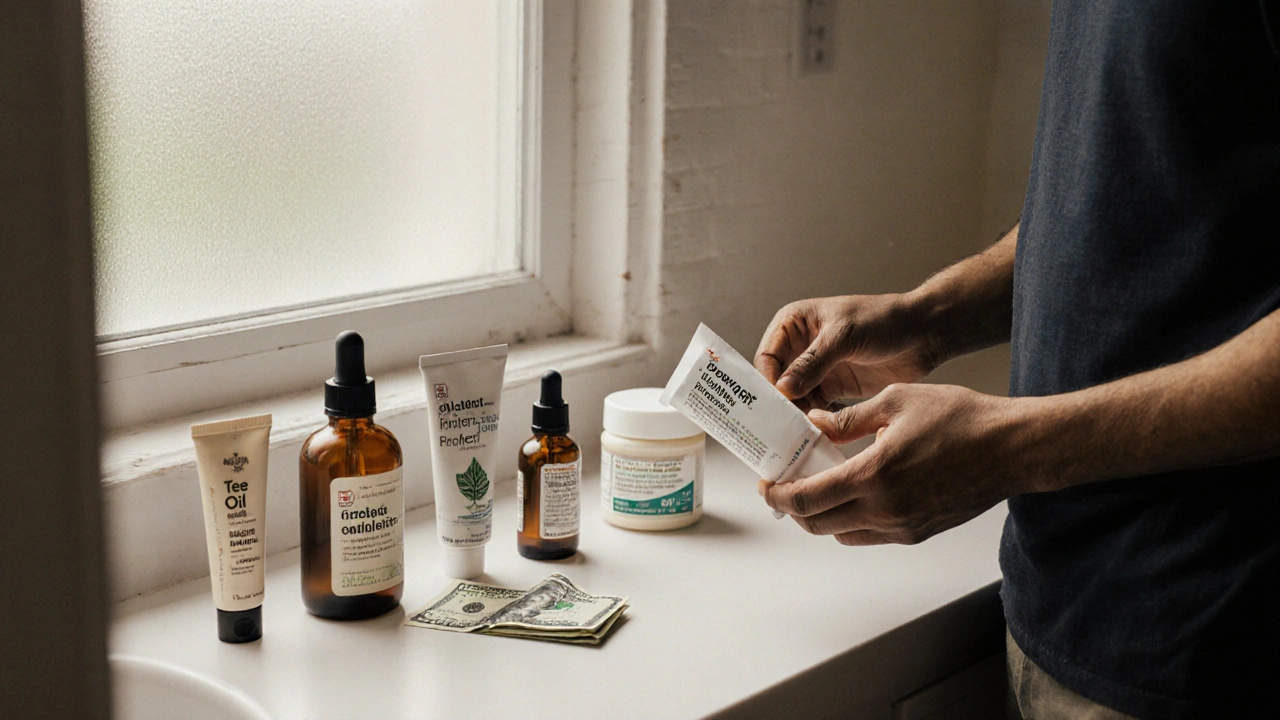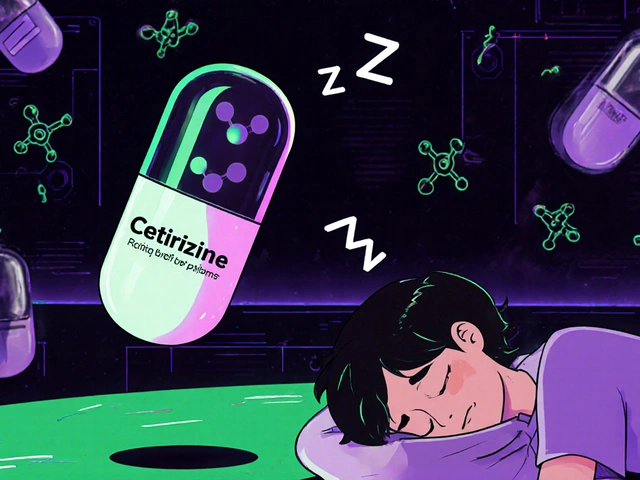Topical Remedy Selector
Choose your situation:
When you hear the name Podowart is a topical formula that blends podophyllum resin, benzoin and aloe vera to calm irritated skin, you probably wonder how it stacks up against the dozens of over‑the‑counter options on pharmacy shelves.
TL;DR
- Podowart combines a strong astringent (podophyllum resin) with soothing agents (benzoin, aloe) for fast relief of minor burns and abrasions.
- Witch hazel offers mild astringency with minimal irritation but lacks the analgesic kick of podophyllum.
- Tea tree oil is antimicrobial but can sting sensitive skin.
- Hydrocortisone cream provides anti‑inflammatory power but isn’t ideal for open wounds.
- Choose based on the wound type, skin sensitivity, and whether you need pain relief or just drying action.
How Podowart Works - The Science Behind the Blend
Understanding the three actives helps you see where Podowart shines.
Podophyllum resin is a concentrated extract from the American mandrake plant that delivers strong astringent and antiseptic properties. It contracts tissue, limits bleeding, and creates a protective barrier that keeps microbes out.
Benzoin is a resin from the Styrax tree that acts as a natural skin protectant and mild analgesic. It adds a pleasant fragrance while reducing the sting that podophyllum can cause.
Aloe vera is a succulent gel rich in polysaccharides that soothes, hydrates, and speeds up epithelial repair. Its cooling effect balances the drying strength of the other two ingredients.
The three together create a formula that stops bleeding, protects the wound, and eases pain within minutes - a combination you rarely see in a single OTC product.
Key Decision Criteria When Picking a Topical Remedy
Before you jump into a side‑by‑side comparison, decide what matters most for your situation.
- Efficacy for the specific condition - burns, cuts, insect bites, or chronic eczema each respond differently.
- Skin tolerance - some users react to strong astringents or essential oils.
- Speed of pain relief - immediate numbing vs gradual soothing.
- Safety profile - any long‑term risks, especially for children or pregnant people.
- Cost and availability - a premium product may be worth it for occasional use, but daily users need affordability.
Side‑by‑Side Comparison Table
| Feature | Podowart | Witch Hazel | Tea Tree Oil | Hydrocortisone 1% | Lidocaine Gel | Zinc Oxide Ointment |
|---|---|---|---|---|---|---|
| Astringent strength | High (podophyllum) | Low‑moderate | Low | None | None | None |
| Analgesic effect | Moderate (benzoin + aloe) | Minimal | Potential sting | Anti‑inflammatory, not numbing | Strong (lidocaine 4%) | Protective barrier only |
| Antimicrobial activity | Good (podophyllum + benzoin) | Moderate | High | Low | Low | Low |
| Suitable for open wounds | Yes (after cleaning) | Yes | Use with caution | Not ideal | Yes | Yes (protects) |
| Potential irritation | Low‑moderate (depends on skin type) | Very low | Moderate‑high | Low | Low | Very low |
| Price per 30ml | £7‑9 | £3‑5 | £4‑6 | £3‑4 | £5‑8 | £4‑6 |
| Availability | Specialist health‑stores & online | Supermarkets, pharmacies | Health‑food shops, online | Pharmacies | Pharmacies, sports stores | Pharmacies, baby‑care aisles |

Deep Dive into the Alternatives
Witch hazel is a water‑based extract of Hamamelis virginiana leaves that offers gentle astringency and anti‑inflammatory action. It’s ideal for acne or minor razor bumps, but its drying power can be insufficient for active bleeding.
Tea tree oil is an essential oil from Melaleuca alternifolia known for broad‑spectrum antimicrobial effects. Athletes love it for fungal foot issues, yet its phenolic compounds can cause burning on raw skin.
Hydrocortisone 1% is a mild corticosteroid that reduces inflammation and itching. It excels for eczema flare‑ups but should never be applied to open cuts because it can delay healing.
Lidocaine gel is a topical anesthetic delivering rapid numbness without affecting the wound’s natural healing process. Perfect for painful insect bites, but it does nothing to stop bleeding or infection.
Zinc oxide ointment is a mineral paste that forms a protective barrier, commonly used for diaper rash and minor abrasions. It shields the wound but lacks any astringent or analgesic action.
Pros and Cons of Podowart in Real‑World Use
Pros
- Combines strong astringency with soothing agents - stops bleeding *and* calms pain.
- Antimicrobial blend reduces infection risk without relying on harsh chemicals.
- Small 30ml bottle lasts weeks for occasional use, keeping cost per application low.
- Fragrance from benzoin masks the unpleasant smell of podophyllum, improving user experience.
Cons
- Podophyllum can irritate very sensitive skin; patch‑test recommended for first‑time users.
- Not as widely stocked as witch hazel or hydrocortisone - you may need to order online.
- Higher upfront price compared to generic astringents.
Choosing the Right Remedy for Your Situation
If you’re dealing with a fresh cut that’s bleeding, Podowart’s high astringent strength gives it an edge over witch hazel and zinc oxide, which may not close vessels quickly enough. For a minor scrape that’s already stopped bleeding, witch hazel or a simple aloe‑gel could be sufficient and cheaper.
When pain is the dominant issue - think sunburn or a painful insect bite - lidocaine gel provides faster numbness, but you’ll still want an antimicrobial partner like tea tree oil or Podowart to keep germs away.
For chronic inflammation such as eczema, a steroid like hydrocortisone is the go‑to, but you should avoid using it on open wounds where Podowart’s protective barrier shines.
Bottom line: match the wound’s stage (bleeding, open, healing) with the key attribute you need (drying, pain relief, anti‑inflammation). Podowart is a strong all‑rounder for acute, bleeding injuries, while the alternatives specialize in niche needs.
Quick Reference Checklist
- Need rapid hemostasis? → Podowart or witch hazel.
- Looking for pure antimicrobial action? → Tea tree oil.
- Require immediate pain numbing? → Lidocaine gel.
- Treat chronic itching or inflammation? → Hydrocortisone 1%.
- Want a protective barrier for diaper rash or skin rubs? → Zinc oxide ointment.
Frequently Asked Questions
Is Podowart safe for children?
Podowart’s podophyllum resin can be irritating on very thin pediatric skin. For kids under 12, doctors usually recommend a milder astringent like witch hazel or a simple aloe‑gel unless a professional specifically prescribes Podowart.
Can I use Podowart on a diabetic foot ulcer?
Diabetic ulcers need careful management. The strong astringent in Podowart may further reduce blood flow, slowing healing. A wound‑care specialist would usually opt for a sterile dressing and a gentle antiseptic rather than Podowart.
How often should I reapply Podowart?
Apply a thin layer after cleaning the area, then re‑apply every 4‑6hours while the wound is open. Once a scab forms, you can reduce frequency to once a day or stop altogether.
Does Podowart interact with other skin products?
Because it’s an astringent, layering it with heavy moisturizers right after application can dilute its effect. Wait 10‑15minutes before applying a bland emollient if you need extra hydration.
What’s the shelf life of Podowart?
Stored in a cool, dark place, the bottle stays effective for 24months from the manufacturing date printed on the label.

Next Steps and Troubleshooting
1. Test first: Dab a pea‑size amount on the inner forearm. Wait 15minutes - if redness or burning persists, consider a milder option.
2. Clean before applying: Rinse the wound with mild soap and lukewarm water, pat dry, then spread a thin film of Podowart.
3. Watch for signs of infection: Increasing redness, pus, or fever means stop the product and seek medical advice.
4. Switch if needed: If you need stronger pain relief after the first few hours, add a lidocaine gel on top of the dried Podowart layer.
5. Store properly: Keep the cap tightly closed and avoid direct sunlight to preserve the resin’s potency.
By following these steps you’ll get the fastest bleeding control and the most comfortable healing experience, whether you stick with Podowart or move to a niche alternative.







Comments
becca skyy
September 28, 2025 AT 11:08 AMI was scrolling through the Podowart breakdown and it actually clicked with a few of my own first‑aid hacks. For a fresh bleed, the high‑strength astringent does what witch hazel can’t – it kinda “clamps” the vessels fast. I’ve also tried the aloe‑benzoin combo on a kitchen burn and the soothing feel was real, not just a scent. If you’re on a budget, the price is still decent for a 30 ml bottle that lasts weeks. Bottom line: it’s a solid all‑rounder when you need both hemostasis and comfort.
Kiersten Denton
October 4, 2025 AT 01:33 AMInteresting rundown, thanks for the details.
Karl Norton
October 9, 2025 AT 15:59 PMHonestly, the article overhypes Podowart like it’s the holy grail of OTC remedies. Most people will never need that level of astringency – a simple sterile bandage does the job. Plus, the price jump over witch hazel is barely justified. If you’re not a medic, stick to the basics.
Courtney Payton
October 15, 2025 AT 06:24 AMi read the piece and i must say it has a lot of good points. the podophyllum resin is indeed powerful but it can bite back on very sensetive skin. a quick patch test on the inner forearm never hurts, and if you see any reddnss back off. also, the benzoine fragrance might be nice for some but not all. overall, it seems like a decent option for those who dont mind a slight sting.
Muthukumaran Ramalingam
October 20, 2025 AT 20:49 PMLook, Karl, I get where you're coming from, but dismissing Podowart outright ignores a lot of real‑world use. I've used it on a few minor cuts at my workshop and the bleeding stopped within minutes, something witch hazel never achieved for me. The astringent strength can be a bit much, sure, but most OTC gels are just as harsh; it's about applying a thin layer. Also, the added aloe does calm the sting, which is something you don't get with plain resin. For anyone dealing with frequent small injuries, the cost per use actually drops pretty low. So maybe it's not a holy grail, but it's a useful tool in the kit.
Garrett Williams
October 26, 2025 AT 11:15 AMPodowart works well for quick bleeding stops and it feels soothing.
joba alex
November 1, 2025 AT 01:40 AMFrom a pharmaco‑technical perspective, the synergistic triad of podophyllum, benzoin, and aloe constitutes a semi‑synthetic matrix that modulates epidermal contractility while mitigating nociceptive feedback. However, the risk‑benefit ratio skews unfavorably for hypersensitive phenotypes, especially when occlusion is employed. In short, it's a niche formulation, not a universal panacea.
Rene Lacey
November 6, 2025 AT 16:05 PMReading the previous analysis, I’m compelled to expand on the underlying biochemistry that makes Podowart stand out among its peers. The podophyllum resin, derived from the American mandrake, contains lignan compounds that act on fibroblast contraction pathways, effectively tightening the wound edges. This mechanical effect is complemented by benzoin’s phenolic constituents, which not only provide a mild analgesic effect but also create a protective film that slows evaporation of the underlying aloe gel. Aloe vera, rich in polysaccharides such as acemannan, promotes cellular migration and re‑epithelialisation, thereby accelerating the healing cascade. When these three agents are combined, the result is a multilayered approach: hemostasis, antimicrobial barrier, and tissue regeneration all in one application. Moreover, the formulation’s pH is calibrated to around 5.5, a level that is optimal for maintaining skin integrity while discouraging pathogenic growth. Clinical anecdotes suggest that users experience a perceptible reduction in bleeding time by up to 50 % compared to standard witch hazel. The analgesic effect, while moderate, is sufficient to blunt the sharp sting associated with raw cuts, which can be a significant comfort factor for individuals with low pain thresholds. Additionally, the antimicrobial spectrum covers gram‑positive bacteria such as Staphylococcus aureus, a common cause of wound infection. This is achieved without relying on harsh antibiotics, thereby reducing the risk of resistance development. The inclusion of benzoin also imparts a pleasant aromatic note, which, while seemingly trivial, can improve user compliance in repeated applications. It should be noted, however, that individuals with extremely sensitive skin may still experience mild erythema, highlighting the importance of a preliminary patch test. From a cost‑effectiveness standpoint, the 30 ml bottle, despite its higher upfront price, translates to a low per‑application expense when used judiciously. In summary, Podowart offers a sophisticated synergy that bridges the gap between simple astringents and more complex wound‑care products, making it a valuable addition to any first‑aid arsenal.
johnson mose
November 12, 2025 AT 06:31 AMWhoa, the table really paints a clear picture – Podowart feels like the Swiss Army knife of creams, while the others each have their own single‑tool vibe. If you’re a hiker who can’t carry a whole pharmacy, that all‑in‑one could save you some hassle. On the flip side, the price might make you think twice if you only need occasional use. Either way, knowing the pros and cons helps you match the remedy to the mishap.